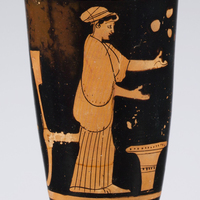Papers by Brajkishor Prasad
Construction and Building Materials, Feb 1, 2019
The AA binder contains 85% GGBFS and 15% powder blended as chemical activators. The AA binder doe... more The AA binder contains 85% GGBFS and 15% powder blended as chemical activators. The AA binder doesn't contain conventional cement or any silicate-based activator. The manufactured specimens using AA binder was cured in water as well as in air. The AA binder performs well as compared to OPC in durability aspects.

International Journal of Environmental Science and Technology, May 24, 2021
In the present investigation, induction furnace (IF) steel slag as coarse aggregate with 0%, 20% ... more In the present investigation, induction furnace (IF) steel slag as coarse aggregate with 0%, 20% and 40% replaced concrete specimens of size 150 × 150 × 150 mm was prepared as an initiative to utilize iron-rich IF steel slag. The casted concrete specimens were cured for 28 days at room temperature (28 °C) in freshwater, and the obtained compressive strength is 22.5, 24.0 and 29.2 N/mm2, respectively. The blocks were then immersed in seawater under laboratory condition for 28 days, and variation in pH was monitored at regular intervals. The composition and mineralogical phases [quartz (SiO2), iscorite (Fe7SiO10), hematite (ε-Fe2O3) and almandine (Fe3Al2Si3O10)] present in IF steel slag were identified using XRF and XRD analysis, respectively. Surface morphology and elemental composition were studied using FESEM with EDAX analysis for before and after immersion of concrete blocks in seawater. Structural bonding of concrete blocks before and after immersion was studied using FTIR analysis. Compressive strength of concrete specimens after the immersion in seawater was evaluated and compared with before immersion in seawater. This initiative will be a major support for induction furnace steel industries via economic benefits. Utilization of iron-rich IF steel slag in marine concrete can be a vital candidate for the betterment of marine ecosystem via primary production of marine resources.
ACI Materials Journal, 1993
h i g h l i g h t s Recycled aggregates were incorporated into mixtures by ratio of 25-30-55%. Co... more h i g h l i g h t s Recycled aggregates were incorporated into mixtures by ratio of 25-30-55%. Compressive strength between 32 and 43 MPa was attained with recycled aggregates. Optimum fiber content was determined as 1% by volume. The greatest negative impact of RCA was experienced at water penetration depths. Use of RCA is more suitable at constructions that have low structural risk factor.

Lecture Notes in Civil Engineering, 2020
The demand for concrete materials in construction becomes huge due to the development of the econ... more The demand for concrete materials in construction becomes huge due to the development of the economy and urbanization in Vietnam. Recently, recycled aggregate concrete has been studied for partly replacing natural stone of concrete in the worldwide. It could save cost for land filling, and con-serve the national resources such as river sand and aggregate. Recycling concrete gives the benefit for environment. However, it may affect to the strength and performance of the construction containing the concrete waste. The paper is a discussion based on the experiments of reinforcement concrete beams with and without recycled concrete. Testing results are simulated by the ATENA program on exploring the behavior of beams. The analysis and experiment results show that replacing 20% of natural stone with re-cycled aggregate concrete does not affect both the bearing capacity and performance of beams.

Proceedings of the ICE - Construction Materials, 2010
A series of uniaxial cyclic tests were conducted on cylindrical specimens of latex-modified concr... more A series of uniaxial cyclic tests were conducted on cylindrical specimens of latex-modified concrete. Cylindrical specimens were cast using normal concrete mix of 30 N/mm2 strength with three different percentages of styrene butadiene rubber latex, namely 5, 10 and 15% by weight of cement. With increase in latex, the water/cement (w/c) ratio was decreased to ensure the same consistency for all the mixes. The parameters considered for the study were latex dispersion, w/c ratio and the concrete strength. The focus of the study was to investigate the stress–strain behaviour of latex-modified concrete and to develop a non-dimensional model with the observed deformation response. The tests included stress–strain envelope curves, common point curves, stability point curves and plastic strain curves. Analytical expressions are established to represent these curves. It is found that the permissible stress level depends on the plastic strain present in the material. The behaviour of latex-mo...
Construction and Building Materials, 2021
The paper deals with the integration of the wear process into a statistical model of the status o... more The paper deals with the integration of the wear process into a statistical model of the status of vehicle tyres. The probabilities of the states are provided by a Markov model. The considered phenomena are the accidental perforation of the tyre, the repair of the perforated tyre and the wear, meaning the loss of rubber material on the tyre surface. The model predicts the probability of exceeding the limit of the safe operating, for a batch of tyres. It is useful to determine the optimum time for the replacement of the tyres. Supplementary, periodic identification of the model parameters allows the setting of an alarm about unusual phenomena that affect the safe operation. More versions of the statistical distributions of the parameters are studied. The results are validated by numerical simulation.

Journal of Structural Fire Engineering
Purpose This paper aims to present an experimental investigation on the performances of alkali-ac... more Purpose This paper aims to present an experimental investigation on the performances of alkali-activated slag (AAS) concrete and Portland slag cement (PSC) concrete under the influence of elevated temperature. In the present study, the alkali-activated binder contains 85% of ground granulated blast furnace slag (GGBFS) and 15% of powder blended as chemical activators. Design/methodology/approach For the purpose, standard size of cube, cylinder and prism have been cast for a designed mix of concrete. The AAS concrete specimens were kept for water as well as air curing. After attaining the maturity of 28 days, the samples were first exposed to different elevated temperatures, i.e. 100°C, 200°C, 300°C, 400°C, 500°C, 600°C, 700°C and 800°C. Later on, the tests were conducted on these samples to find the change in weight and the residual strength of the concrete. Findings After 500°C exposure, a considerable amount of the strength loss has been observed for AAS concrete. It has been eval...











Uploads
Papers by Brajkishor Prasad